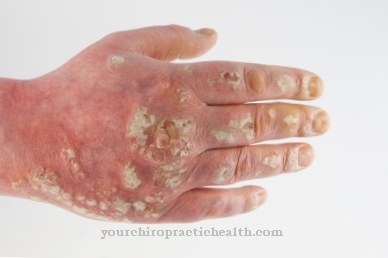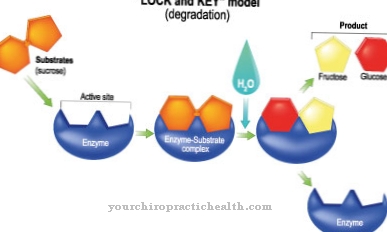At Erythema exudativum multiforme (EEM) is an inflammatory rash on the skin or mucous membrane. Due to the optical similarity of the rosette-shaped skin foci with military cockades, erythema exudativum multifome is also referred to as cockade erythema and the foci as target lesions.
What is erythema exudativum multiforme?

© Neokryuger - stock.adobe.com
With Ertyhema exudativum multiforme, ring-shaped skin lesions, often with a purple center surrounded by a bluish halo, develop on the patient's skin. A pale ring is visible in between, like a cockade or target. Often the herd look like coins lying next to each other, individually or in groups.
There are two forms that differ in severity and course. In the mild form, the EEM minor, patients usually do not feel sick. The cockade-shaped foci are mainly found on the skin of the back of the hand and the extensor side of the forearm. There is little or no blistering, the mucous membranes are not affected.
In the severe form (EEM major), the general condition of the patient is worsened. The entire body, including the feet, palms of the hands and the lining of the mouth, may be affected by the rash, with blisters in the center of the focus.
The transition to Stevens-Johnson Syndrome is fluid, a variant of EEM Major with severe skin involvement of the entire body. Here the mucous membranes on the mouth, eyes or genitals are also affected. The risk of secondary infection is high and scars are often left after the erythema has healed.
causes
Many erythema exudativum multiforme diseases follow infection with herpes simplex viruses. It is believed that fragments of herpes simplex DNA cause a cell-damaging reaction in cells of the epidermis. Measured against the total number of herpes simplex infections, this is rare. Therefore, a genetic predisposition is also assumed.
Other viral or bacterial infections, mycoses, vaccines, preservatives or certain drugs are also listed under the causes. Antibiotics, so-called hydantoins (partly contained in anti-epileptic drugs) or pyrazolones (partly contained in painkillers) are among other things suspected of causing erythema multiforme.
With the EEM minor form, the trigger cannot be determined in 60 percent of the cases. If the herpes simplex virus is the cause, a chronic form with relapsing attacks can develop. EEM Major, on the other hand, occurs as a one-off disease - almost always drug-induced, due to cell-toxic side effects (cytotoxic reaction).
You can find your medication here
➔ Medicines against redness and eczemaSymptoms, ailments & signs
Erythema exudativum multiforme often comes as a surprise to the patient. A rash suddenly forms on the skin consisting of spots, papules, wheals or blisters, at skin level, slightly raised or eroded deeper into the skin. The lesions are reminiscent of cockades or shooting targets with a purple center and a bluish outer ring.
In the major form, the rash often spreads from the extremities to the trunk. In the mouth area, you can also notice vesicles on the palate and gums or target lesions on the lips. Itching may appear with the rash.
Anyone who has been infected with the herpes simplex virus, first observed a fiber blister on the lips and then noticed a very itchy rash on arms and legs, should see a doctor. In Stevens-Johnson syndrome, there are also fever, enlarged lymph nodes, liver and spleen.
The mucous membranes are always affected, often preceded by catarrh-like symptoms. The variations in skin manifestations range from a few target lesions to extensive, scarlet-like rashes.
Diagnosis & course
The diagnosis is usually based on the clinical picture. In the anamnesis, overcome infections or mycoses are taken into account, but also medication intake and their temporal relationship.
Without any significant harbingers, a rash forms on the extremities or the whole body. The reddish papules initially measure 0.1 to 0.3 centimeters. Within 24 hours they expand into target-shaped cockades, in the major form with central bubbles.
The rash can affect the back of the hand, palms and soles of the feet, occur in the neck, face, throat or on the extensor sides of the arms and manifest itself in groups around the elbows or knees. In around 50 percent of cases, there is mild (mostly oral) infection of the mucous membrane, on the lips, cheek mucosa and tongue. Joint swelling and pain can occur.
In the major form, the general condition is clearly limited. Histological examinations are not conclusive, the laboratory mostly normal, and occasionally increased inflammation levels occur, including eosinophilia.
Complications
Erythema exudativum multiforme often develops after an infectious disease and manifests itself as an inflammatory rash that can affect the mucous membranes. A drug reaction, tumor infestation, the outbreak of a herpes simplex virus and infection by reproductive bacteria or streptococci are considered to be the cause of the symptom.
Surprisingly, the affected person tends to develop blister-like wheals, which form a ring-shaped bluish skin reaction, the center of which stands out in a strong purple. The visible appearance is called, among other things, the target. As the disease progresses, itchy foci of different sizes develop.
Erythema exudativum multiforme is divided into major and minor forms. At the first signs, those affected should therefore seek medical assistance immediately, especially if a herpes simplex virus has previously broken out. If medical therapy is not initiated early, complications increase and become chronic.
The symptom affects the entire body and manifests itself on the mucous membranes. As the skin progresses, scratching causes scars. There are also attacks of fever and enlargements of the liver, spleen and lymph nodes and there is a smooth transition to the so-called Stevens-Johnson syndrome.
Depending on the cause of erythema exudativum multiforme, various countermeasures are prescribed in medical therapy in the form of anti-inflammatory glucocorticoids as well as skin lotions and mouth rinses to relieve symptoms.
When should you go to the doctor?
Rash should always be medically examined and treated. If the affected regions expand or if they increase in intensity, a doctor's visit is recommended. If the general locomotion can no longer take place as usual due to the skin changes, a doctor should be consulted.
If the body is in poor posture or if the muscles are in pain due to a crooked posture, a doctor is required. Without a correction there is a risk of permanent damage to the skeletal system. If objects can no longer be held as usual due to the discomfort in the hands or if the general performance limit drops, it is advisable to consult a doctor.
If there are changes in the mucous membranes in the mouth or open wounds, a doctor's visit is necessary. Germs can get into the organism and lead to new diseases. Put fever; If you feel dizzy or feel sick, a doctor is needed. If swelling or skin discoloration occurs, a doctor should examine the affected areas and give medical attention.
If the eyes and genitals are affected, the symptoms should be clarified by a doctor. If there are changes in vision or psychological problems arise, a doctor is required. If the blistering of the skin occurs for no apparent reason, it is considered unusual and should be investigated.
Doctors & therapists in your area
Treatment & Therapy
EEM is an acute self-limited disease and the skin lesions heal on their own within two weeks. Treatment is limited to symptomatic therapy.
Good experiences have been made with the external treatment of skin lesions with Lotio alba, a shaking mixture made from aqueous zinc oxide. Joint swelling is combated with cool compresses or pads, or a local antihistamine.
Glucocorticoid-containing creams such as 0.1 percent triamcinolone cream or 0.05 to 1 percent betamethasone emulsion help against annoying itching. In the case of lesions of the oral mucosa, mouthwashes with chamomile extract bring relief.
In the more severe major form, systemic glucocorticoids such as prednisone can be prescribed for intensive treatment of the affected mucous membranes. Antibiotics to prevent secondary infections may also be advisable. Oral antihistamines such as desloratadine or cetirizine can be used against severe itching.
Outlook & forecast
The erythema exudativum multiforme has a favorable prognosis. The changes in the complexion occur acutely and thus trigger the impression of a serious disorder. Ultimately, however, the symptoms regress completely within a few weeks. Most patients are symptom-free in less than fourteen days.
In addition, they do not need medical support to alleviate the symptoms, as the organism regenerates itself. If there are no complications due to itching or the visual blemish, the healing process will be short-lived and without medical care.
The overall prognosis is less favorable as soon as there are further diseases. In many cases, the erythema multiforme is a side effect of another disease. Although the skin changes recede without any external influence or the administration of medication, there are often complex diseases that have to be treated.
The prognosis for these diseases is often unfavorable or protracted. The weaker the patient's immune system is due to the underlying disease, the more likely there are delays in the healing process of the erythema multiforme.
In addition, the risk of complications is increased. In the case of open wounds, pathogens can enter the organism and cause sepsis. There is thus a potential risk to life. Fever attacks are also possible. They temporarily weaken the patient further.
You can find your medication here
➔ Medicines against redness and eczemaprevention
If a triggering substance has been identified beyond any doubt, it is sufficient for the patient to avoid it in the future in order to prevent EEM from occurring again. In patients with frequent relapses due to the herpes simplex virus, suppressive antiviral therapy can help - either briefly or as long-term therapy, for example with acyclovir.
Aftercare
With erythema exudativum multiforme, in most cases there are no special or direct measures and options for follow-up care available to the person affected. With this disease, the person affected is primarily dependent on rapid and early treatment and diagnosis so that the symptoms do not worsen further. As a rule, there is no independent healing, so a visit to a doctor is always necessary.
If you have erythema multiforme, you should definitely rest and take care of your body. Here you should refrain from exertion or other stressful and physical activities so that there are no further complications. The person concerned should also take the medication prescribed by the doctor regularly and in the correct dosage.
The doctor should then be consulted if there are any questions or other uncertainties. Regular examinations of the inflammation by a doctor are also important in order to monitor and control the current status at all times. With a successful treatment of erythema exudativum multiforme, there is usually no reduction in life expectancy. No further aftercare measures are necessary.
You can do that yourself
EEM is an acute illness that must first be clarified by a doctor. The treatment can be supported by various measures.
If it is suspected that a drug is responsible for the erythema exudativum multiforme, the responsible drug must be discontinued. Those affected should speak to the responsible doctor about this. The skin lesions must always be treated with medicinal drugs. Sometimes the antihistamines used can be supplemented with cooling compresses.
Cooling helps especially with swelling of the joints, be it in the form of compresses, cooling sprays or compresses. However, the use of appropriate resources must be discussed with a doctor beforehand in order to avoid adverse events. In the case of the severe major form, medical treatment is definitely required.
Those affected can support the therapy by protecting the mucous membranes. Dietary measures, for example, are ideal for this: a diet without spicy, acidic or overly hot foods and avoiding luxury foods such as coffee or alcohol. If the symptoms persist despite all measures or even increase in intensity, a doctor must be consulted. The erythema exudativum multiforme may be caused by a serious condition that needs to be diagnosed and treated.

.jpg)

























